Day Two…
Preamble
9.00am
Looking northwards from the Tsar’s position on the hills before Dresden
and the Gross Garten, the left has Schwarzenberg’s Austrians deployed
with a Korps under Colloredo [2 battalions of grenzers, 6 of fusiliers,
2 of landwehr plus a foot battery and 2 regiments of hussars] furthest
to the left while Merville’s Korps [1 battalion of jägers, another of
freiwilliger volunteers, 6 fusilier and 2 landwehr battalions, 2 foot
artillery batteries supported by 2 regiments of uhlans] threatens to
advance on the Paper Mill and the Reserve Korps [3 grenadier battalions
and 2 regiments each of kurassier, dragoons and hussars with a small
cavalry battery in support]waits patiently on the heights south of Ober
Gorbitz.
Facing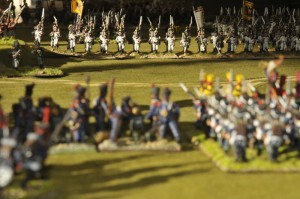 them the Emperor has Victor’s Corps [3 battalions of légère, 6
them the Emperor has Victor’s Corps [3 battalions of légère, 6
ligne with 2 foot batteries and a light cavalry regiment] thinly spread
from Friedrichstadt to the Paper Mill but near the bank of the River
Elbe is the mass of Murat’s Cavalry Reserve [five divisions [GdB
brigades] of horse, totalling 5 regiments of cuirassiers, 3 of dragoons
and 2 each of hussars and chasseurs].
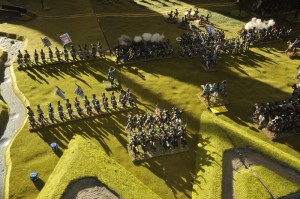 In the centre, Blücher’s Prussians have deployed two large divisions
In the centre, Blücher’s Prussians have deployed two large divisions
[again GdB brigades, this time with a total of 6 battalions of
fusiliers/musketeers, 5 battalions of Landwehr, 2 foot batteries and a
regiment of hussars]. Facing them are St Cyr’s “Frenchmen” [actually
Bavarians…. 2 battalions of light infantry, 8 battalions of line, 3
regiments of light cavalry and no fewer than 4 batteries of guns]. Not
the best troops in terms of quality [most of the infantry has been
rated “2nd class”] they have the advantage of defending three redoubts
as well as the formidable structure of the Gross Garten itself.
On the allied right wing there are the Tsar’s own Russians. His Guard
[3 battalions of infantry including the famed Pavlovski, a regiment of
guard lancers and a large foot battery, plus the cavalry reserve of 2
regiments of cuirassiers and 2 regiments of dragoons] under Grand Duke
Constantine patiently await orders on the hills looking down on the
Gross Garten whilst Gorchkov and Wurttemburg lead their Corps forward
[each Corps has two divisions/brigades comprised of a total of 2
battalions of jägers, 4 of musketeers, 1 each of militia and grenadiers
plus a 6-gun foot battery] with Pahlen’s Cavalry Corps boldly pushing
towards the very banks of the Elbe with their cossacks [2 regiments]
and hussars [2 regiments, supported by a horse battery].
Opposite the Russians are Marmont’s French [5 battalions of infantry, 3
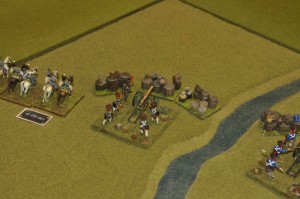 foot batteries – two of them entrenched in redoubts – and a light
foot batteries – two of them entrenched in redoubts – and a light
cavalry regiment]. The north bank of the River Elbe has some further
French batteries defending it and providing enfilade fire against
Russians pushing too deep towards Dresden’s Neustadt. This is also the
most likely theatre to see the commitment of the Young Guard [some 11
battalions commanded by Ney and Mortier], whilst the Old Guard and
Artillery of the Guard are in Dresden as a final reserve.
9.15am
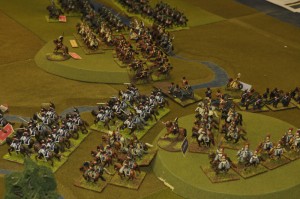 On the left [from the Allied perspective] Murat’s cavalry surges
On the left [from the Allied perspective] Murat’s cavalry surges
forward [it is on “Attack”], only to see an entire French dragoon
division [brigade] disorder themselves crossing a fairly innocuous-
looking stream. Colloredo’s Austrian light cavalry withdraws towards
its supporting infantry [both Colloredo and Merville are on “Hold”
orders] whilst Victor’s artillery near the Paper Mill takes the
opportunity to open fire – no doubt “softening up” the enemy for when
Murat’s advance reaches them!
In the centre Blücher waits [his Corps in also on “Hold” orders]…
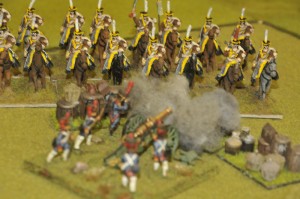 On the right it is the Russians who move forward: Pahlen quite
On the right it is the Russians who move forward: Pahlen quite
aggressively [both brigades on “Engage” rather than “Assault”] looking
to flank the French artillery redoubts near the Elbe with his light
horse; Wurttemburg more cautiously deploying against the Gross Garten
preparatory to a deliberate attack; Gorshkov linking the two formations
[his Corps is “Supporting” his neighbours].
9:30am
The French dragoons continue to struggle with the apparently daunting
“command exercise” of crossing a stream – it would appear that it is
not only the horseflesh which leaves something to be desired in 1813
[the French dragoons are rated “Inferior Mounts”].
In the centre Blücher throws out some skirmishers but otherwise waits…
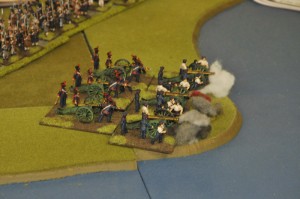 Pahlen’s Russian cavalry, in their desire to demonstrate in front of
Pahlen’s Russian cavalry, in their desire to demonstrate in front of
Marmont’s artillery redoubts, gets close enough to the Elbe to receive
the attention of French gunners on the far bank. However, it appears
the French artillery park may have moved into the Altstadt a little
prematurely [the French guns receive a “Low on Ammo” result].
9.45am
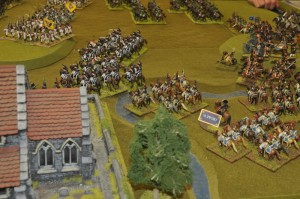 The French dragoons finally manage to reform. Murat’s Cavalry Corps
The French dragoons finally manage to reform. Murat’s Cavalry Corps
certainly looks threatening but will they have room to deploy?
Colloredo prudently deems it time to form square with his left-hand
division, although he is conscious that the French must have horse
artillery in support of such a mass of troopers. Elsewhere on the
Austrian front some jäger are less prudent and come within canister
range of a French battery near the Paper Mill.
In the centre Blücher skirmishes and waits….
The Russians continue their slow deployment before the Gross Garten.
When the frontal assault eventually does come it looks as if the Garten
will already have been flanked: the defending Bavarians may find
themselves exposed to cross-fire from Russian reserve artillery on the
hills to the south and musketeers to the north.
10.00am
Murat has his two batteries of excellent French horse artillery in
position and must now only work out how to give them a clear field of
fire to the tempting target of the Austrian squares: for the moment the
hapless French dragoons are in the way. The rest of Murat’s cavalry is
pressing forward under the relentless pressure of the Emperor’s orders
to attack [Murat is compelled to have at least some brigades on
“Assault” orders and that means advancing. Indeed it can force units to
charge even if the only viable targets are enemy squares…].
It finally seems to have dawned on someone at the Tsar’s HQ that
Blücher needs a new set of orders and the Tsar promptly sets off to
find the doughty veteran…
On the Russian front, Pahlen finally satisfies himself that he is in
position to threaten the redoubts and Wurttmenburg’s infantry are
beginning to breach the high walls surrounding the Gross Garten.
Meanwhile artillery fire continues to be exchanged.
10.15am
Murat executes a masterly piece of command: he changes the orders of
his dragoon division allowing them to unmask his horse artillery which
he has massed as a grand battery. The first cannonade is clearly more
of a ranging-shot – only 2 casualties inflicted – but the Austrian
squares will surely be subjected to a merciless bombardment… However,
Murat’s timing is a little off and two of his divisions – one of
cuirassiers and one of chasseurs à cheval – are obliged to commit
themselves prematurely to a charge. For the cuirassiers the outcome is
more embarrassing than self-destructive as their lead regiment bounces
off a battalion of Austrian fusiliers. For the chasseurs it is rather
less forgiving: a single volley from the Austrian battalion they are
attacking fells a quarter of the regiment which promptly pulls up
[“Falters”], leaving brave General Chastelet to continue the charge
alone, straight into the middle of the Austrians where he is promptly
captured [“Double Six” from enemy fire carries with it a threat to
senior officers as well as potential serious consequences for units on
the receiving end]. Fortunately, the morale of the chasseur division
survives the loss of their commander as the next senior officer takes
over.
In anticipation of Murat’s advance rolling-up the Austrian flank,
Victor prepares to advance one of his divisions [orders successfully
changed from “Defend” to “Engage”].
Blücher receives new orders from the Tsar and the Prussian hordes begin
to advance in the centre.
On the far right of the Allied line Pahlen too changes pace and tactics
[he puts the Cossack division on “Assault”].
10.30am
Rather to their surprise the Allies seize the initiative [the Tsar has
a -1 modified, Napoleon has +1 in addition to the “+1 for being French”
golden rule…]. Immediately Pahlen launches two cavalry charges at the
northernmost French artillery redoubt and the supporting light cavalry
regiment. To no one’s particular surprise one cossack regiment is
promptly shredded by canister fire but the other cossack regiment
presses home against a counter-charge from the French hussars. In the
ensuing melée it emerges that the French cavalry have been suffering
from the attention of Pahlen’s horse battery for nearly an hour and
have rather fewer troopers in the saddle than first appeared
[casualties are recorded on paper rather than bases removed, mostly so
generals have to work without instant visual clues as to the likely
outcomes of their decisions] and the much more numerous but poor
quality cossacks are easy winners. Impressed by their victory they
immediately retired to their own lines to compare notes on their
heroism.
Elsewhere on the Russian front the attack on the Gross Garten is
building up. There are now three Russian battalions inside the walls.
Of itself this ought not worry the three defending Bavarian battalions
unduly, but there are also Russian musketeers lining the Gross Garten
to the northern flank and militia with their sharp-looking pikes are
lurking beyond the gate…
Murat’s advance on the opposite flank risks being stalled as his
chasseur division again flings itself forward against the same square
which proved Chastelet’s undoing. A second chasseur à cheval regiment
charges and a second general succumbs to Austrian musketry [another
“Double Six”]. Lasalle may have considered a hussar who lived beyond
thirty to be a disgrace to his uniform but the chasseurs may soon run
out of senior officers. Again, however, the division withstands the
loss of its [rather temporary] commander.
10.45am
French regained the initiative and pushed on with Murat’s attack
against the Austrian left. A devastating carronade by the French horse
artillery felled a third of a defending fusilier square but this time
it would be Austrian morale which held firm despite the commanding
general taking the opportunity to seek medical assistance for a minor
wound [a French “Double Six” this time!].
In the Gross Garten charges were exchanged between Bavarian and Russian
lines. In one the Russian musketeers failed to press home but opted
instead to engage in a musketry duel at close range. In the other
charge the Bavarians pushed on and actually routed the more numerous
Russian jäger in hand-to-hand combat. However, the surviving Bavarians
– though remaining formed and under their officers control [they passed
their Formation Test] – were now rather depleted.
Pahlen’s aggressive spirit had spread from his cossacks to his hussars
who bravely charged a French artillery redoubt. Defensive canister fire
proved ominously ineffective but rather to Marmont’s surprise the
French gunners chose to fight for their guns. Even with the benefit of
field fortifications it was a forlorn hope and the victorious Russian
hussars cut down the artillerymen with little difficulty, capturing the
redoubt and then displaying admirable self-control to occupy the
position and even contemplate a further charge [a “Superb Discipline”
result on their Cavalry Pursuit check].
11.00am
The Allies took the initiative for a second time in the morning though
Pahlen’s cavalry decided to rest on their much deserved laurels having
successfully cleared the French from the southern bank of the Elbe
[their “Attack” order changing to “Hold” as they accomplished their
mission].
In the Gross Garten the victorious Bavarian battalion tried to exploit
their success against the Russian jägers by declaring a charge on the
unformed Russian musketeers now to their front [the unit have been
disordered by the jägers routing through them] but despite the
favourable tactical situation the Bavarians were feeling the effect of
one-third cumulative losses [a “Falter” result on their test to
charge]. On the northern flank of the Gross Garten the Russian infantry
advance was beginning to look ominous for Marmont; where was the
Guard?
In the centre Blücher had finally managed to sort out his artillery and
it would only be a matter of time before the Prussian infantry pressed
on St Cyr’s out-numbered men. However, the frontage available to the
Prussians – even after securing Plauen – was heavily restricted and
there were two artillery redoubts to their front which they lacked the
weight of shot to neutralise: it looks as if it will be bloody work for
the infantry to do it alone.
On the Austrian front a French cuirassier regiment and a reformed
chasseur regiment tried once more to break through the now rather more
battered Austrian squares. Once more they were deflected by stout
Austrian defence. However, a more serious threat to Austrian sangfroid
was emerging in the form of Victor’s right flank division [brigade]
which had advanced from Friedrichtstadt. Those Austrian fusilier
battalions still in line were able to open up an effective musketry
duel – one of Victor’s three battalions losing 20% of its strength from
a single enemy volley – but where Austrian square faced French line the
exchange was bound to be unequal; and there was still the matter of
Murat’s horse artillery…
11.15am
Two hours into the second day of the battle and matters very much hang
in the balance. Murat has rearranged his Cavalry Corps in order to
create room and bring up more heavy cavalry to threaten Colloredo’s
Austrian squares, some of which are also facing an extended and deadly
musketry duel with Victor’s infantry. On the other hand, the majority
of Colloredo’s infantry squares are relatively unscathed and his light
cavalry are uncommitted whilst Merville’s Korps is free to threaten
Victor’s other divisions near the Paper Mill, and the Reserve Korps
remains available as a powerful counter-attacking force.
Blücher’s advance in the centre has been slow – not helped by the loss
of a general to Bavarian skirmishers – but numbers must eventually tell
if the French cannot achieve victory elsewhere on the battlefield. In
the Gross Garten the Russians have pushed the Bavarians back though the
latter still hold the palace in the middle of the park. Further north
Pahlen has created a gap on the flank but will need the support of
Gorshkov’s infantry to exploit it. Paradoxically, indeed, the Russian
advance now presents the French with the opportunity to introduce the
Young Guard as they now have a flank to target. Whether a French
counter-attack on either or both wings can develop fast enough and
decisively enough is doubtful, however, given the weight of Allied
forces available.

![]()

